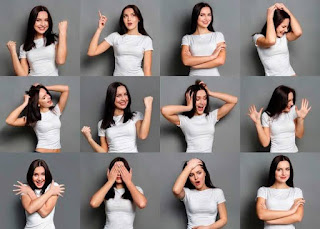“THE HUMAN CONNECTION”
Valentina Salazar, tercero
Body language
Body language refers to non-verbal communication through gestures, facial expressions, posture and body movements. It is an important form of communication, as it often reveals emotions and feelings unconsciously.
Components of body language:
Facial Expression:
Facial expressions can convey a wide range of emotions, such as joy, sadness, anger, surprise, fear, and disgust.
Gestures:
Hand and arm movements can complement or emphasize speech, or function as independent signals.
Temper:
The way the body is held can indicate confidence, insecurity, openness, or defensiveness.
Eye Contact:
The gaze can show interest, attentiveness, sincerity, or lack of connection.
Proxemics:
The use of personal space and distance between people when communicating.
Appearance:
The way we dress, style our hair, and groom ourselves can convey messages about our personality, social
*Also when we are sad we tend to have a lowered gaze, glassy eyes and we tend to make slower movements than normal.
Body language in female people
Female body language can vary, but it generally includes subtle movements, facial expressions, and postures that can indicate interest, nervousness, or even submission. Signs such as prolonged eye contact, leaning toward the person you're interacting with, and mirroring gestures are common when a woman is attracted. It's also important to consider that some women may display nervous gestures such as playing with their hair or jewelry, especially in stressful situations.
Some specific aspects of female body language are :
Eye contact:
Sustained eye contact for 2-3 seconds, followed by a downward glance, can be a sign of interest, while averting one's gaze or looking sideways could indicate disinterest or nervousness.
Body lean:
Leaning toward the person you are interacting with indicates receptivity, while turning away or leaning back may be a sign of reservation .
Gesture mirroring:
The "mirror effect," where one person mimics the gestures of another, can be a sign of connection and attraction.
Posture:
An open posture, without crossing arms, can indicate receptivity, while crossing arms can be a sign of defensiveness or disinterest.
Hand gestures:
Playing with hair, jewelry or touching the neck may indicate nervousness or flirtation.
Facial expressions:
Raising eyebrows can be a friendly social greeting, while lowering the head and looking up can be a sign of flirtation.
Tone of voice:
An upward rising tone at the end of a sentence may be perceived as submissive, while a downward tone at the end of a sentence may convey more.
Some common male body language gestures include maintaining prolonged eye contact, adjusting clothing or hair in the presence of someone they're attracted to, and leaning slightly forward when talking to someone they're interested in. Other indicators can include posture, hand movements, and the way they use their personal space.
Posture:
Straight, open posture: Indicates confidence and self-assurance.
Slouching posture: May suggest insecurity, shyness, or fatigue.
Arms crossed: Often interpreted as a sign of defense or rejection, although it can also indicate that they're cold or simply comfortable in that position.
Hands on waist: Can convey an attitude of defiance, aggression, or confidence.
Hands and arms:
Hands in pockets:
Could indicate nervousness or an attempt to hide something.
Playing with objects:
Adjusting a tie, watch, or any small object can be a sign of nervousness or an attempt at seduction.
Showing his palms:
A man who shows his palms while speaking may be seeking to connect on a deeper emotional level or to be sincere.
Hands clasped behind his back:
This can be a sign of confidence and control, or of being in deep thought.
Gaze:
Prolonged eye contact: Indicates interest, trust, and a desire to connect with the other person.
Looking down: Could suggest lack of interest or shyness.
Looking up and down: If accompanied by other gestures, this can be a sign of sexual interest or attraction.
Dilated pupils: An increase in the size of the pupils can indicate liking or attraction.
Other gestures:
Nodding:
This can indicate agreement, interest, or submission, but it can also be a sign that they've heard enough.
Touching their face:
This can be an innuendo or a flirtatious gesture.
Breaking away from a group:
If a man breaks away from a group to approach a woman, it may be a sign that he is interested in her.




Comments
Post a Comment